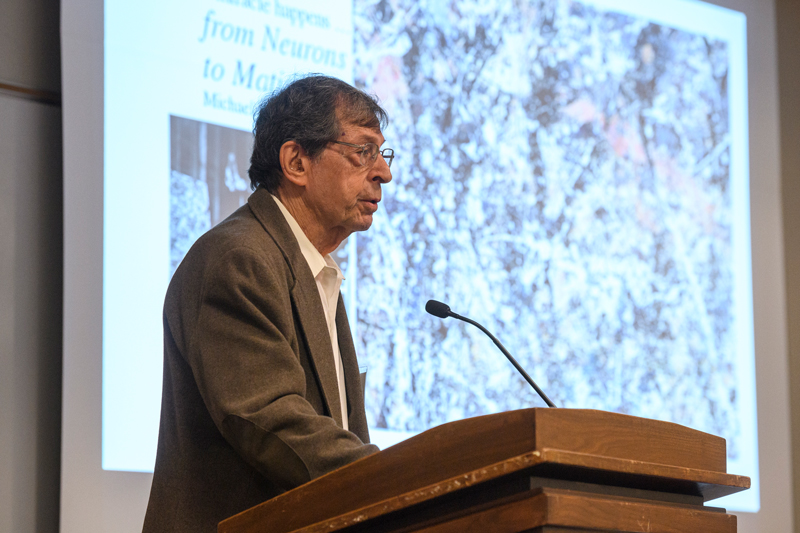


UDARF Lecture, ‘From Neurons to Matisse’
December 22, 2017
Professor Emeritus Michael Greenberg discusses a theory behind art appreciation
“What is art?” is an age old question that lingers because there is no right answer or interpretation. Taking a different type of analytical approach, Michael Greenberg attempted to address this question during a recent luncheon for the University of Delaware Association of Retired Faculty (UDARF) in Clayton Hall.
“We’ve been to the moon. We’ve even managed to come back and we’ve done many incredible things, but there’s one age old question that’s still on the books: ‘How does art work?’ ” Greenberg said. “It’s the question of art, I believe, and it’s really been untouched.”
He promised the audience this wouldn’t be another lecture on neuroaesthetics, which often uses a scientific approach by looking at entire systems and processes to explain the arts. Neuroaesthetics is like the new kid on the block, he said.
“I don’t see how neuroaesthetics is positioned to answer the question, ‘How does art work?’ ” Greenberg said. “To illustrate that point, this book, Introduction to Neuroaesthetics, has a painting on the cover, but you flip through the 450 pages and you don’t find a single picture.”
A retired professor from the College of Engineering’s Department of Mechanical Engineering, Greenberg instead dedicated his 30-minute presentation to the neuron. Focusing on the micro-level actions of a neuron, we can understand how our vision works when looking at art, Greenberg said. Much of our interpretation has to do with nonlinearity, which is an idea that change does not always have proportional or direct cause and effect.
A fellow retired professor from the audience asked, “What does this have to do with nonlinearity?”
Greenberg used two works of art to prove his point. The first work by an artist Greenberg said he truly admires was “The Dance” by Henri Matisse. The artwork, shows a circle of women holding hands. Pointing out the shapes created by the hands, Greenberg said our eyes follow the jagged patterns and our brains sees depth perception. The concept of figure-ground is one example of this.
The idea behind figure-ground is that your brain is able to distinguish between the figures in an image and what is supposed to be the background, said Greenberg. Your eyes and brain pick up on these cues.
“Figure-ground is not where we’re going, but it gets our foot in the door,” said Greenberg. Think of it as “jumps,” he told the audience. These different “jumps” processing in our brain ultimately create sustained pleasure and hence we enjoy a piece of art.
To bring his point home, he turned to the painting “Green Chair,” by Milton Avery, where he argued our natural ability to create depth perception does not work. To the eyes, this photo looks flat. Greenberg pointed out an unnatural section where the table, floor, and wall of the photo meet at one point, he said, failing to create the illusion that the table is in the foreground.
If a portion of a painting is off or counters our natural understanding of how things work, the brain will not adjust said Greenberg. In order to have an appreciation for a work of art, it has to logically work with our brain’s natural process of correcting.
“The bottom line, I think, in understanding art, is a different way of looking at it,” Greenberg said. “And it’s based on a model which has to be based on physiology. You don’t need the whole brain to figure this out. A simple neuron gives you all the clues you need.”
Contact Us
Have a UDaily story idea?
Contact us at ocm@udel.edu
Members of the press
Contact us at 302-831-NEWS or visit the Media Relations website

